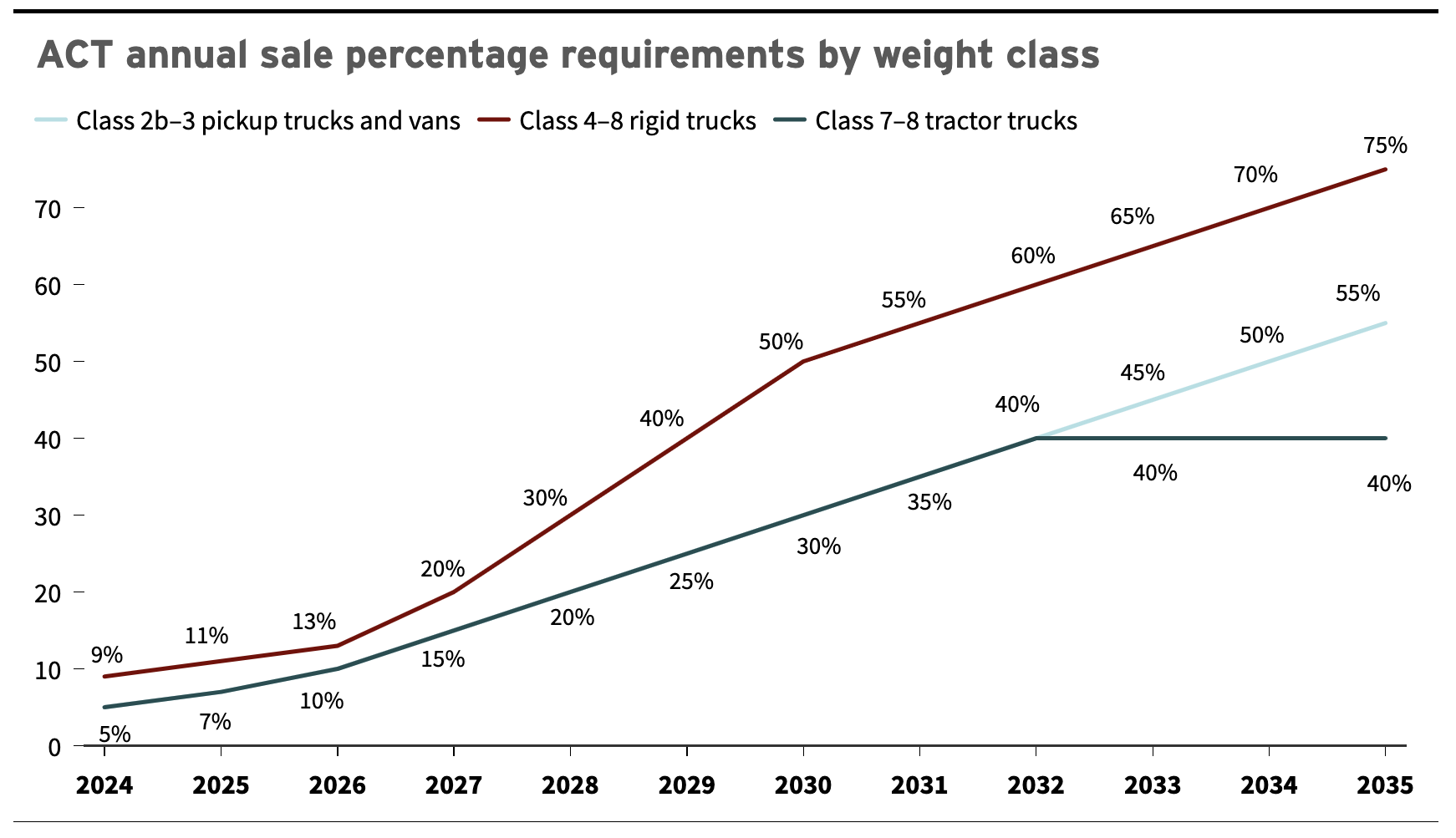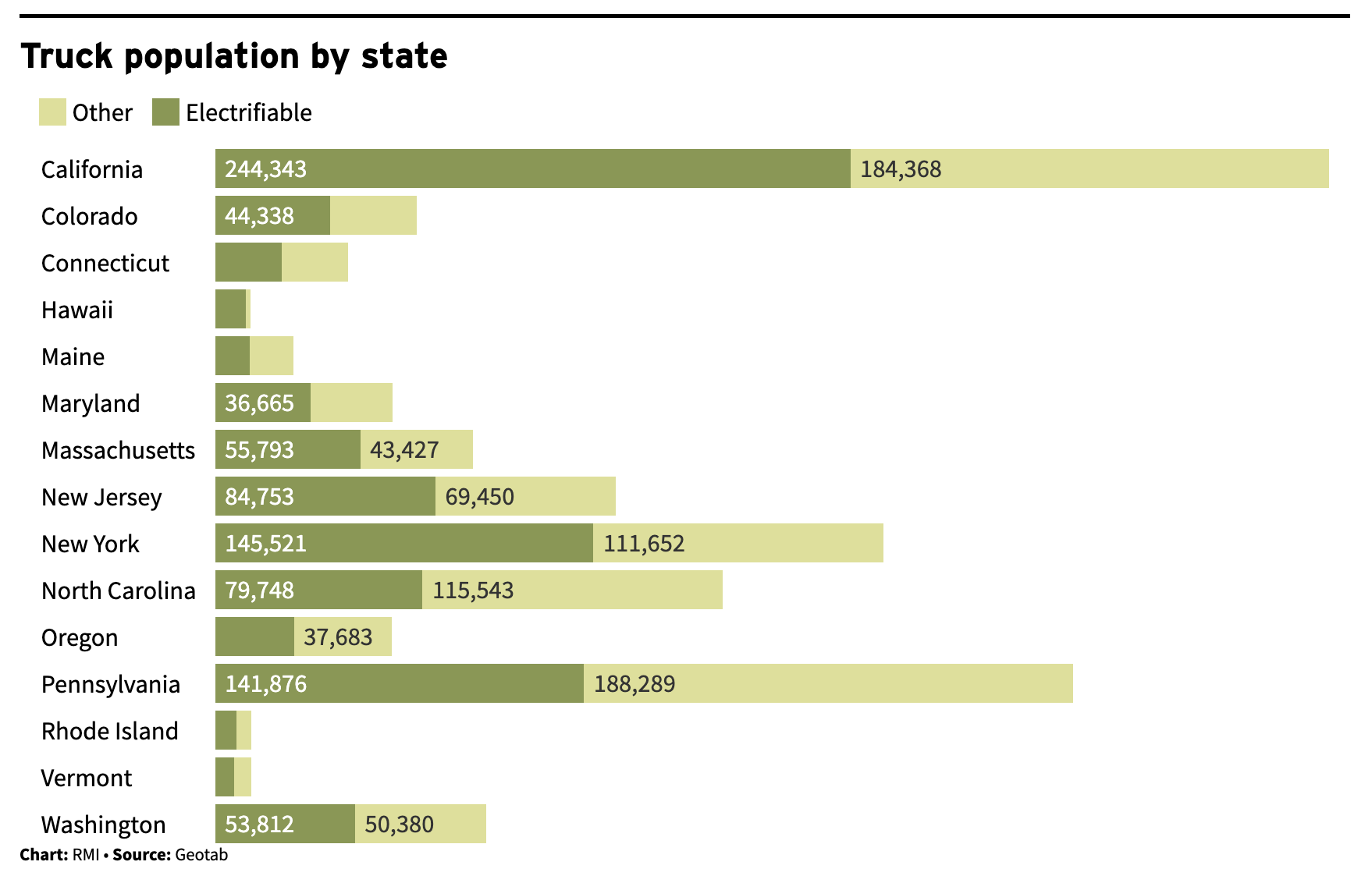An analysis of 15 states that have adopted or are in the process of adopting the Advanced Clean Trucks regulation shows that 60 percent of medium-duty trucks and 43 of heavy-duty trucks are electrifiable today.
In the United States, the transportation sector contributes more greenhouse gas (GHG) emissions than any other. Given that medium- and heavy-duty (MHD) trucks account for only 10 percent of vehicles on the road, yet produce almost a quarter of the sector’s emissions, it’s clear that truck electrification will be critical to meeting climate goals.
To accelerate adoption, an increasing number of stakeholders are exploring how policy can help address commonly cited barriers to truck electrification, including fleets’ concerns about the cost of electric trucks, electric trucks’ ability to meet operational needs, and whether the electric grid can adequately provide for the charging needs of electric trucks.
To address these concerns, RMI analyzed one year of trucking telematics data in 15 states that have adopted or are working to adopt the Advanced Clean Trucks (ACT) regulation to understand how trucks currently operate and to quantify electrification potential. The profiled states have all signed the Advanced Clean Trucks Memorandum of Understanding (MOU) that requires 30 percent of MHD vehicle sales be zero-emissions vehicles (ZEVs) by 2030, with a goal of 100 percent ZEV adoption by 2050. Some states have enacted the MOU, while others are still working on adoption.
We found that, on average in these areas, 60 percent of medium-duty trucks and 43 percent of heavy-duty trucks are electrifiable today.
What Is the Advanced Clean Trucks (ACT) Regulation?
To understand the results of RMI’s analysis, it’s important to know what the ACT regulation does. First adopted in California in 2020 to combat truck emissions, ACT requires original equipment manufacturers (OEMs) of MHD vehicles to sell ZEVs or near-zero-emissions vehicles (NZEVs) such as plug-in electric hybrids as an increasing percentage of their annual sales from 2024 to 2035 to achieve 100 percent sales of electric trucks by 2050. The regulation uses a cap-and-trade system, capping the number of fossil fuel vehicles sold by stipulating annual sales percentage requirements. The rule allows manufacturers to comply with the regulation by generating compliance credits through the sale of ZEVs or NZEVs or through the trading of compliance credits. For further background on ACT please review RMI’s article Understanding California’s Advanced Clean Truck Regulation.
Can electric trucks and charging capabilities meet operational needs?
In many cases, yes.
RMI defines electrifiable trucks (i.e., trucks that could be electrified in the next three years) as those that drive 300 miles or less before returning to a home base. These criteria—limited travel distance and return to a fixed base—are chosen for two reasons:
- While some of today’s electric trucks are capable of driving up to 500 miles on a single charge, others are capped at 100–200 miles. The 300-mile cutoff aims to reflect the capabilities of currently available electric truck models.
- Today public and/or shared charging infrastructure for electric trucks is limited, so most electric trucks must rely on depot-based charging.
It’s important to note that electric truck ranges are expected to increase in the coming years as battery technology improves and costs decline. Extended ranges and more charging infrastructure will increase the market for electric trucks.
RMI found in the 15 assessed ACT states 60 percent of MD trucks and 43 percent of heavy-duty HD trucks are electrifiable today. Below, you can see how many trucks are easily electrifiable in each of the ACT states.
Can the grid handle truck electrification?
Given that full truck electrification would increase national yearly electricity consumption by almost 10 percent, it’s understandable that many are concerned that the grid may not be able to power electric fleets. As electric truck adoption increases, fleets, utilities, and regulators are working to understand how to optimize business practices, strengthen grid infrastructure, and improve charging and operational design to reduce trucks’ energy use.
Initial truck electrification will likely exert only a moderate strain on our power grids. Looking at regions considering ACT, RMI assessed the potential repercussions on the grid of electrifying all trucks that are electrifiable with existing models. With mostly overnight charging, there would be a 5 percent rise in energy consumption for trucks suited for electrification. In the areas analyzed, peak power demand could surge anywhere from nearly nothing up to 14 percent, averaging around 3 percent. However, these figures might fluctuate based on the charging tactics employed, and each region possesses its unique attributes that will influence the optimal charging method. Despite the need for thoughtful grid management and investment, overall grid capacity should not deter ACT implementation. However, local impacts of truck charging aggregated on a small number of feeders can present challenges, highlighting the need for fleets to fleets to begin fleet electrification conversations with their utilities as early as possible.
That said, many short- and medium-haul trucks have relatively low energy needs and therefore are easier to electrify than many believe. RMI found that these electrifiable trucks regularly spend 16 hours per day parked at a depot and eight hours driving. These long depot dwell times are well suited to slow, low-powered charging. RMI found that half of these electrifiable trucks would be able to use Level 1 and Level 2 chargers (I.e., less than 25kW) if electrified. The benefit of using these lower-powered chargers is that they minimize burden on the grid and are more affordable to install.
How much do electric trucks help public health and air quality?
Electrifying trucks offers profound environmental and community benefits beyond just curbing greenhouse gas emissions. RMI analysis projects that by transitioning to electric trucks across all ACT states we could avert 477 premature deaths and curtail 6,194 asthma incidents annually. This translates to a staggering health benefit of $5.3 billion.
It’s crucial to highlight that communities of color and lower-income households are disproportionately situated near trucking facilities. Truck electrification is a pivotal step forward, albeit one that addresses only some aspects of the broader challenges associated with environmental racism. In addition to air pollution associated health risks from diesel trucks, electric trucks don’t produce the engine and brake noises that can degrade quality of life and adversely impact health.
Are electric trucks affordable?
While RMI’s most recent analysis did not cover trucks’ affordability, it’s a common enough concern to address here. The Inflation Reduction Act (IRA), passed in 2022, has greatly reduced the price of electric trucks through its Qualified Commercial Vehicle Tax Credit, which provides up to $40,000 in tax credits for the purchase of electric trucks. This significant tax credit shows the power of policy to advance truck electrification. RMI projects that, thanks to the IRA, electric short- and medium-haul trucks’ total cost of ownership will be lower than that of their diesel counterparts five years sooner than if the law had not been passed. Truck makers such as Tesla have noted that driving electric can save hundreds of thousands of dollars in fuel over the course of its time on the road. And by as soon as 2030, more than 60 percent of new trucks sales could be electric.
The Qualified Commercial Tax Credit is just one of many available sources of funding; state and federal grants and vouchers also make trucks more affordable. (For more detailed information on funding for electric trucks, check out this article from Mike Roeth, director of the North American Council for Freight Efficiency).
The Power of Policy
Existing federal, state, and local policies play a key role in accelerating electric truck adoption by creating:
- Voluntary incentives like tax credits and grant and loan programs to make it more affordable to purchase, charge, and produce electric trucks;
- Enforceable rules that require automotive companies and other stakeholders to produce vehicles that reduce emissions; and
- Market certainty that encourages private investors and automotive companies to fully embrace electric vehicles.
Over the past two years there has been groundbreaking investment in clean transportation from the federal government through two key pieces of federal legislation: the Bipartisan Infrastructure Law (BIL) and the IRA.
The chart below provides an overview of key federal and state policies that support MHD electric truck adoption.
For more information on this analysis please check out RMI’s Early Trucking Electrification in ACT States dashboard.






